June 13, 2010 – 11:20 pm ET
Performance Update – The original readers of this newsletter will remember the Global ETF rotation model that we developed about 6 years ago. Well that model has now been independently verified by Timertrac for just over two years. During that period the S&P 500 is down -19.84% while our model is up 114.07% (in our own account we are up 187.93% due to the use of some leverage).
These results have NOT been achieved through day trading, picking penny stocks or complicated options positions. They have been achieved with just 19 trades over the last two years on ETFs that are so diversified they track entire countries. I challenge you to find proof of similar performance especially with such diversification and low frequency of trading.
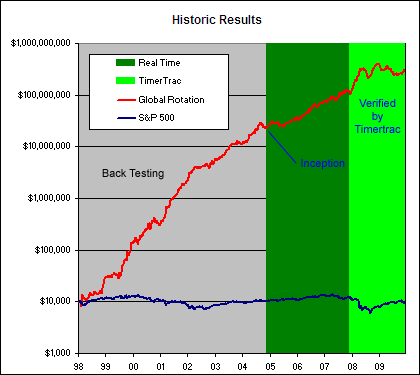
We are considering making this model available through autotrade or subscription at some point to a limited number of people. See the last two years of verified results – HERE.
.
To The Markets – It was a very interesting week, nearly all the occurrences we were looking for to indicate a continuation of the bearish trend happened on Monday. The only confirmation that didn’t come was a secondary breakdown of OBV by IYT and I was surprised to see the market finish so strongly for the week. So, did we get our levels wrong or is this just another bear market rally? Lets take a closer look:
.
ETF % Change Comparison
.
I would give far more weight to the advances over the last few days if they were being lead by SMH and QQQQ, instead the comparatively economically stable SPY and DIA out performed. To complicate matters however, IYT (Dow Transportation Index ETF) was the top performer advancing a healthy 3.75%. It is strange for the transports to do so well if the market really is sick. The coming week will be telling.
.
What the % Comparison Table Tells Us:
By comparing the performance of the economically sensitive (SMH, QQQQ, IWM, IYT) and the comparatively stable ETFs (SPY and DIA) we can get an indication of the true market direction. The more sensitive areas of the market tend to be the first to initiate a trend change. For example if DIA and SPY sell off heavily while SMH and IWM (Russell 2000 small cap ETF) sell of mildly or continue moving to new highs then this would be very positive and vice versa.
The ‘Average Rank %’ is calculated by subtracting the % change for each ETF from the maximum % change and dividing it by the range for each period. 1-((MAX(% change all ETFs)-ETFs % Change)/(MAX(% change all ETFs)-MIN(% change all ETFs))) The readings for each period are then averaged. This reading is provided because if one ETF was significantly under/out performing the others then a plain high or low rank would not accurately reflect this.
.
![]()
.
A Look at the Charts
.
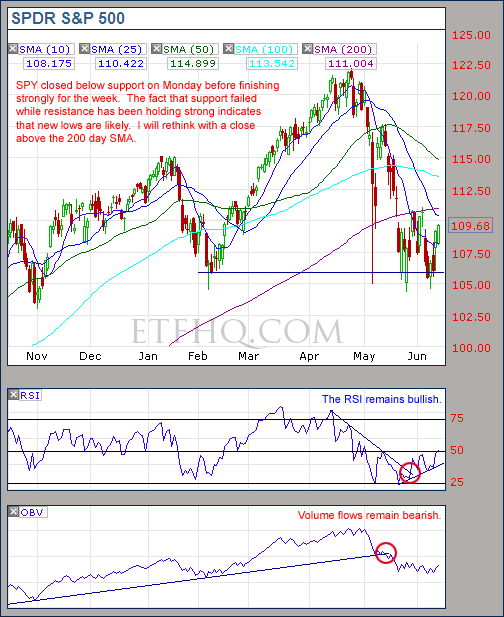
At this point resistance is proving to be stronger that support indicating that another violent downward leg is on the way.
.
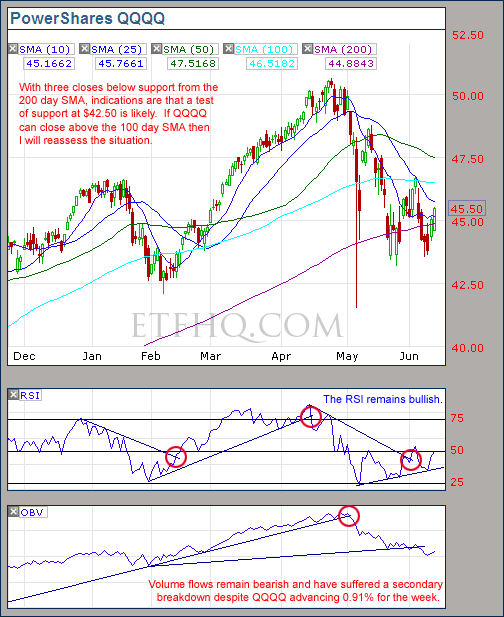
QQQQ under performed the broad market over the last week, briefly failed a test of support and volume flows have deteriorated. This is not a good sign.
.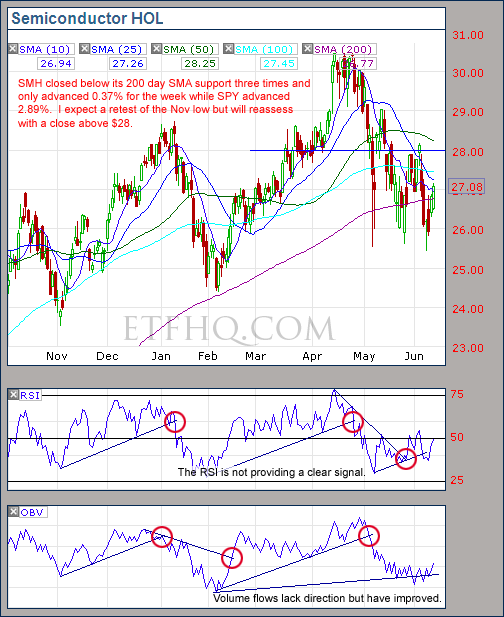
SMH had a comparatively lack luster week but volume flows have improved. Resistance at $28 is likely to hold.
.
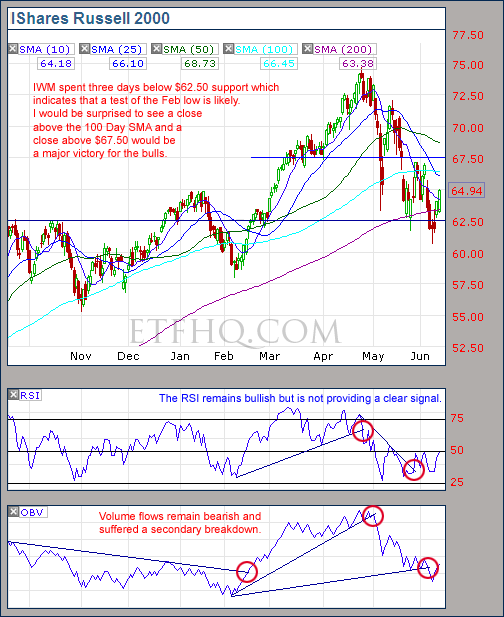
IWM suffered a secondary break down by OBV and a brief loss of support. Further declines are likely but a close above $67.50 would be a major victory for the bulls!
.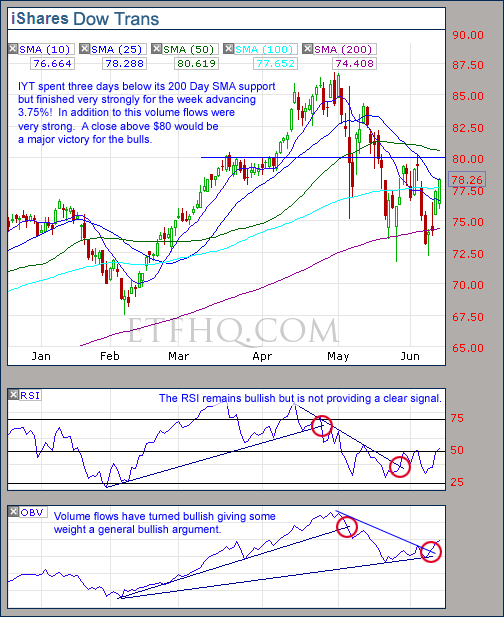
IYT offers the strongest bullish argument at the moment. Volume flows never suffered the secondary breakdown we needed to confirm a continuation of the bearish trend and instead have turned bullish. It is likely that resistance will hold strong but a close above $80 would be a major victory for the bulls.
.
![]()
.
OM3 Weekly Indicator
.

The OM3 indicator has produced its first bull alerts in 7 weeks. It would be far more bullish however if they came from the more economically sensitive ETFs rather than from DIA and SPY.
.
How to read the OM3 indicator
The OM3 indicator as with most of our models primarily reads price action and volume. The strong/weak buy/sell signals are self-explanatory. ‘No Signal’ means that the component readings are in conflict and cancel each other out.
The alerts let you know if the cycle is speeding up or slowing down, so when you get at ‘Strong Buy, Bear Alert’ for instance it simply means that the criteria for a strong buy is in place but this weeks cycle reading is weaker (or more bearish) than last weeks reading (the same is true in reverse).
The number of weeks that a signal has been repeated is displayed. Historically a ‘Strong Buy’ signal has lasted for an average of 6 weeks and a maximum of 42 weeks, while a ‘Strong Sell’ has lasted for an average of 4 weeks and a maximum of 16.
This is an indicator not a mechanical trading model. It is useful to assist in analyzing the market but for the best results should be combined with commonsense and support/resistance levels etc.
.
![]()
.
TransDow & NasDow
.
The Transports remain dominant over the Dow after 105 days and have advanced 4.48% during that time easily outperforming the Dow that has declined -1.11% over the same period. For the NasDow there is currently no clearly dominant index.
.
What the TransDow Readings tell us:
The TransDow measures dominance between the DJ Transportation Index (DJTI) and the Dow Jones Industrial Average (DJIA). In a strong market the more economically sensitive Transportation Index should be dominant over the DJIA.
Historically the DJTI has been dominant over the Dow 45% of the time. The annualized rate of return from the DJTI during this period was 18.47% with the biggest loss for one trade sitting at -13.27%. The annualized return from the DJIA during the periods it was dominant over the DJTI was just 4.06% and the biggest loss for one trade was -16.13%. A 4% stop-loss is applied to all trades adjusting positions only at the end of the week.
What the NasDow Readings tell us:
The NasDow measures dominance between the NASDAQ and the DJIA. Using the same theory behind the Trans Dow; in a strong market the more economically sensitive NASDAQ should be dominant over the DJIA.
Historically the NASDAQ has been dominant over the DJIA 44% of the time. Taking only the trades when the NASDAQ is above its 40 week moving average the annualized rate of return was 25.47% with the biggest loss for one trade sitting at –8.59%. The annualized rate on the DJIA during the periods it was dominant over the NASDAQ is just 8.88% and the biggest loss for one trade was –12.28%. A 8% stop-loss is applied to all trades adjusting positions only at the end of the week.
.
![]()
.
LTMF 80 & Liquid Q
.
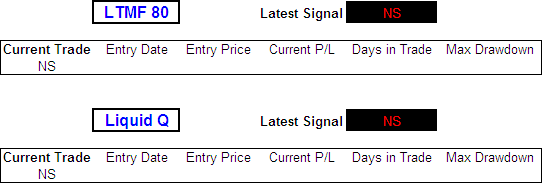
Both LTMF 80 and Liquid Q remain in cash.
.
Historical Stats:
.

.
How The LTMF 80 Works
LTMF stands for Long Term Market Forecaster. It reads volume flows relative to price action and looks for out performance of volume measured on a percentage basis over the prior 12 months. During a sustained rally the readings will reach high levels (near 100%) making it imposable for the volume reading to always outperform price so any reading above 80% will maintain the buy signal. This system has outperformed the market over the last 10 years but performance has been damaged by some nasty losses. It only produces buy signals and only for QQQQ.
How Liquid Q Works
Liquid Q completely ignores price action and instead measures the relative flow of money between a selection of economically sensitive and comparatively stable ares of the market. It looks for times when the smart money is confident and and can be seen by through volume investing heavily is more risky areas due to an expectation of expansion. This system has outperformed the market over the last 10 years and remained in cash through most of the major declines. It only produces buy signals and only for QQQQ. We will provide more performance details on the web site for these systems soon.
.
![]()
.
Summary
.
To confirm a continuation of the bearish trend we were looking for:
- SPY close below 105.89 (Feb Low) – Achieved
- QQQQ close below 200 Day SMA and OBV secondary breakdown – Achieved
- SMH close below 200 Day SMA, OBV secondary breakdown and RSI turning bearish – Achieved
- IWM close below $62.50 and OBV secondary breakdown – Achieved
- IYT close below 200 Day SMA and OBV secondary breakdown – Not Achieved
Most support levels were broken even if only briefly while in contrast; when the market last came up against resistance it couldn’t break through. This is the behavior of a bear market and is further confirmed by deteriorating volume flows from QQQQ and IWM. However if we see resistance levels being broken then the situation will need to be reassessed. If SMH closes above $28, IWM above $67.50 and IYT above $80 then I will be taking profits on my short positions.
.
Any disputes, questions, queries, comments or theories are most welcome in the comments section below.
.
Derry
And the Team @ ETF HQ
“Equipping you to win on Wall St so that you can reach your financial goals.”
.
P.S Like ETFHQ on Facebook – HERE
.
![]()
.
The Devils Dictionary – T
Tangible Common Equity – Unknown origin; Definition unknown; Purpose unknown; How it’s calculated, unknown; What federal regulators think it means, unknown. Usages: “Macbeth,” Shakespeare, W., Act II, Scene (i): “Is this TCE which I see before me… I have thee not, and yet I see thee still.”
Too Big To Fail – Banks, insurance companies, car companies, presidential approval ratings, Fed chairmen seeking second terms, other people who think they should be Fed chairman, the reputations of people who’d be responsible for letting things fail. Antonym: Too Boring To Save.
Toxic Assets – 1. A collection of bad loans and other botched financial bets that caused big losses for banks, prompted a credit crunch and sank the economy (Sept. 2008 to May 2009). 2. Long-term investments that will pay handsomely when the housing market recovers (June 2009 onward).